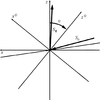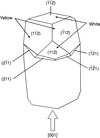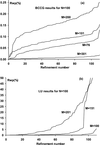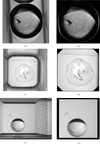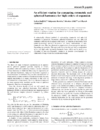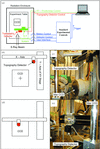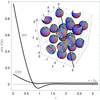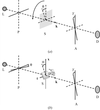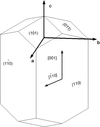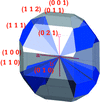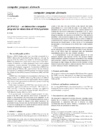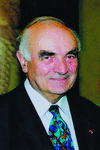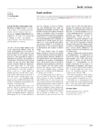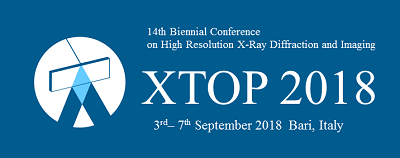issue contents
June 2005 issue

Cover illustration: Secondary electron image of a crystalline iron ore sinter phase, produced by heating to 1533 K and then cooling. Courtesy of N. V. Y. Scarlett, I. C. Madsen, M. I. Pownceby & A. N. Christensen [J. Appl. Cryst. (2004), 37, 362-368].
research papers
The UB matrix approach has been extended to inelastic neutron scattering instruments, with calculations presented for triple-axis and time-of-flight spectrometers.
Cryoprotectant requirements for successful flash-cooling of protein precipitant solutions were determined; these requirements were found to be a strong function of cryoloop size and appear to correlate with the glass transition temperature of the solution. Detailed key data are presented in tabular form.
The inhomogeneity in the nanostructure of a single wool fibre was investigated by scanning microbeam small-angle X-ray scattering.
Models for counting losses in X-ray detection systems are examined. A convenient and versatile formula for correcting count losses is presented.
The distribution of Pb/Bi over the 11 crystallographically distinct sites in Pb5Bi6Se14 was determined from resonant scattering data that had been recorded at ∼86 keV, and just below both the Pb and Bi K-edges, using an imaging plate detector and synchrotron radiation.
X-ray topographic images of the threading edge, axial screw and basal plane dislocations that occur in SiC epilayers deposited on offcut SiC substrates are computer simulated and compared with experimental topographs.
Point defects and their clusters in bismuth germanate single crystals free from grain boundaries and having low density of dislocations were studied by high-resolution diffuse X-ray scattering measurements.
Small modifications to the conjugate gradient method for solving symmetric positive definite systems have resulted in an increase in performance over LU decomposition by a factor of around 84 for solving a dense system of 1325 unknowns. Performance is further increased in the case of applying upper- and lower-bound parameter constraints.
One of the design goals of the neutron time-of-flight (TOF) diffractometer HIPPO (High Pressure–Preferred Orientation) at LANSCE (Los Alamos Neutron Science Center) was efficient quantitative texture analysis. In this paper, the effects of the HIPPO detector geometry and layout on texture analysis, particularly the shape and dimensions of the detector panels, are investigated in detail.
Single crystals of different Cu–Ni–Co and Cu–Ni–Fe alloys, forming spheroid or plate-like precipitates during decomposition, have been studied by small-angle (SAXS) and wide-angle X-ray scattering (WAXS). The SAXS patterns gave information on the sizes and the organization of the precipitates, while the scattering near Bragg peaks allowed a determination of the distortions of the lattice created by these precipitates.
The analytic expression for the small-angle neutron scattering spectrometer that uses a refractive focusing optic is derived.
Open  access
access
 access
accessThis paper discusses methods for improved processing of images in the automated analysis of crystallization experiments for high-throughput X-ray crystallography
A numerically efficient method of constructing symmetric real spherical harmonic bases is presented. This approach allows for fast and stable computation up to very high order, which can be used in e.g. averaging of non-crystallographic symmetry in protein crystallography or refinement of large viruses in electron microscopy.
Open  access
access
 access
accessA method is presented for the measurement, using small-angle X-ray scattering (SAXS), of the microfibril angle and the associated standard deviation for the cellulose microfibrils in the S2 layer of the cell walls of softwood specimens.
A system which automatically couples digital topography with fine φ-sliced reflection profiling has been developed and applied to cryocrystallography.
Operating with the pair correlation function, geometric properties and characteristic SAS parameters of a special tightly packed arrangement of hard spheres of constant diameter are investigated. Starting from the SAS correlation function of a hard-particle `dead leaves' model, the distribution density of isotropic uniform random chords, belonging to the connected phase, is determined analytically.
Download citation


Download citation


A superstructure induced by a high-spin to low-spin transition is described.
The orientation relations between three phases of CdTe were studied under high pressure using X-ray diffraction. Three different transition mechanisms are discussed.
Download citation


Download citation


Determination of the absolute optical rotation of CsLiB6O10 by the TILTER and HAUP techniques is described.
short communications
Studies of glucose isomerase from Streptomyces rubiginosus by small-angle X-ray scattering indicate that it could be a more stable molecular weight standard for SAXS than bovine serum albumin.
computer programs
Crys.m is a MATLAB routine that combines a micrograph of a crystal with a scaleable, rotatable three-dimensional cage structure to determine the orientation of the crystal axes.
A tool was developed to aid in the visualization of weak or irregular features in electron density which are difficult or impossible to observe using isosurfaces. This tool has been integrated into an existing molecular visualization package, PyMol, making it possible to observe and interact simultaneously with a structure model and the electron density slices.
This article presents a Windows application, WinXMorph, with which near reality crystal morphologies are made and exported as virtual reality files in the VRML V2.0 format.
laboratory notes
New tools and an advanced protocol are presented for improving the throughput in manual crystallization using 96-well microplates. The described procedures and devices help to reduce setup time and costs.
A design for a modular air cooler (`crystallization comb') installed in a laboratory chamber furnace is presented. The setup allows regulation of a series of crystallization parameters in crucible columns, with the purpose of obtaining crystals.
computer program abstracts
The program displays three-dimensional images of Fourier maps and solvent-accessible voids.
A parallel version of Queen of Spades, which encodes an algorithm for a stochastic multidimensional approach to molecular replacement, is presented.
An interactive computer program for the simulation of higher-order Laue zone (HOLZ) line patterns is presented. The program was written in Java using the kinematical approximation and a first-order dynamic correction.
crystallographers
Free 

book reviews
Free 



 journal menu
journal menu













